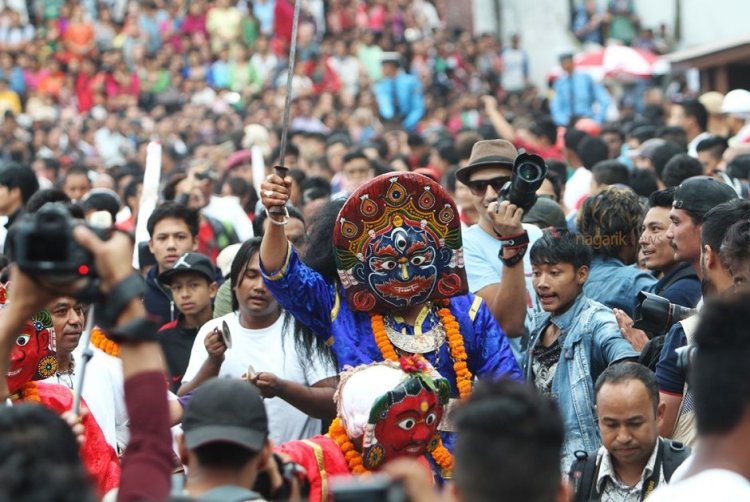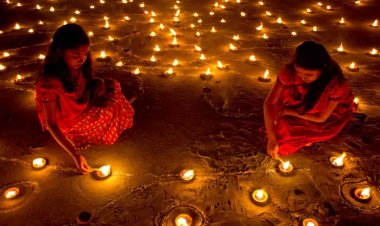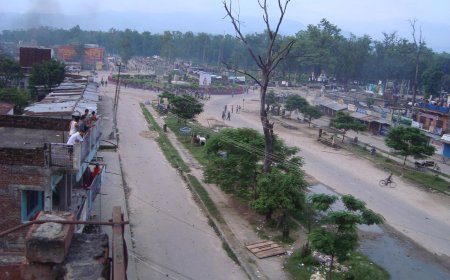Indra Jatra: Nepal's Enchanting Masked Dances
Explore the rich tapestry of Nepal's Indra Jatra festival, adorned with enchanting masked dances. Dive into the cultural significance, historical stories, and spiritual heritage of this mesmerizing celebration.

Introduction
Indra Jatra, a vibrant and sacred festival in Nepal, is a testament to the country's rich cultural tapestry. As one of the most significant celebrations in the Kathmandu Valley, this ancient festival seamlessly blends tradition and faith. In this comprehensive guide, we'll delve into the origins, captivating legends, eight days of spirited festivities, the role of chariots, and the enchanting masked dances that make Indra Jatra a cultural treasure.
Origins of Indra Jatra
Indra Jatra is a festival deeply rooted in Nepal's cultural history, with its origins tracing back to the 11th century. The festival is a beautiful tapestry of tradition, faith, and captivating legends that encapsulate the spirit of the Kathmandu Valley. Here's an in-depth exploration of the origins of this grand celebration:
-
Centuries of Tradition:
Indra Jatra stands as a testament to the enduring power of tradition. Its roots go deep into Nepal's past, with its practices and rituals being observed for centuries. This continuity reflects the cultural significance and the unwavering commitment of the people to their heritage. -
Dynastic Influences:
The festival's evolution is intricately tied to the dynasties that have ruled Nepal over the centuries. Each dynasty has left its unique imprint on the celebration, shaping the way it is observed. From the Lichhavi Period to the Malla Dynasty and beyond, the festival has adapted to the changing political landscape. -
Legends and Myths:
One of the most captivating aspects of Indra Jatra is the rich tapestry of legends and myths that surround it. One prevalent story centers around Lord Indra's journey to Nepal. In this myth, Lord Indra descended from the heavens in search of a special herb. Disguised in human form, he was accused of theft, leading to a fascinating sequence of events. These legends add depth and allure to the festival, making it a truly unique cultural experience.
Eight Days of Spirited Celebrations
Indra Jatra is a grandiose celebration that spans eight days, igniting the Kathmandu Valley with enthusiasm and vibrant displays of tradition and faith. Let's explore each day of this festival:
-
Pole-Raising Ceremony:
The festival kicks off with the erection of a massive wooden pole made of pine in Basantapur Square, which is in front of the old Hanuman Dhoka Palace. Hundreds of spectators gather to witness this significant event. The pole-raising ceremony signifies the commencement of Indra Jatra and sets the stage for a series of captivating rituals and festivities. -
Charms of Kathmandu Durbar Square:
The beating heart of Indra Jatra is Kathmandu Durbar Square. Every night, this historical square transforms into a mesmerizing spectacle with its ancient shrines and palace buildings adorned with oil wicks. The mesmerizing illumination draws both locals and tourists alike to bask in the ethereal ambiance and partake in the festivities. -
Vivid Chariot Processions:
Among the most enthralling aspects of Indra Jatra are the grand chariot processions. Three chariots take center stage: Kumari's, Bhairav's, and Ganesh's. These ornate chariots are paraded through the bustling streets of Kathmandu, with fervent devotees pulling them with great excitement and reverence. The processions are a vibrant showcase of the strong connection between the people and their deities. -
Mesmerizing Cultural Dances:
Throughout the festival, the streets come alive with masked dancers known as Lakhay. These dancers, bedecked in colorful costumes and masks, grace the thoroughfares with their rhythmic moves. Their performances are accompanied by the resonant beats of traditional drums. These dances not only entertain but also convey tales of mythology and ancient legends, adding depth to the cultural significance of Indra Jatra. -
Enchanting Shrines and Temples:
In the evenings, the ancient palace buildings and shrines around Kathmandu Durbar Square are adorned with flickering oil wicks. The area takes on an almost surreal, enchanting atmosphere that showcases the rich spiritual heritage of Nepal. -
Ten Incarnations of Lord Vishnu:
Each night on a platform in front of the temple of the Living Goddess, an enactment depicting the ten earthly incarnations of Lord Vishnu takes place. These captivating performances delve into the mythology and spirituality of the festival, captivating the audience and deepening their connection to the ancient stories. -
Akash Bhairab's Display:
In an extraordinary display of devotion, the large image of Akash Bhairab's head is placed out in the open, directly facing his temple at Indra Chowk. This display symbolizes the powerful bond between the people and their deities, reinforcing the significance of Indra Jatra. -
Living Goddess Kumari's Procession:
One of the festival's highlights is the chariot procession of Kumari, the Living Goddess. The procession takes place on the afternoon of the day before the full moon. Devotees and spectators gather near Hanuman Dhoka Palace, eager to catch a glimpse of this revered Newar girl who embodies divinity. The grand procession featuring Kumari, Bhairav, and Ganesh chariots is a spectacle that draws thousands of people. It symbolizes the unique fusion of monarchy and spirituality, a testament to the enduring traditions of Nepal.
These eight days of spirited celebrations epitomize the essence of Indra Jatra, bringing to life the cultural and spiritual heritage of the Kathmandu Valley in a whirlwind of rituals, dances, and vibrant processions.
Enchanting Masked Dances
Indra Jatra is not just a festival; it is a vibrant cultural exposition. At its heart are the enchanting masked dances that captivate both locals and visitors. These dances are a living testament to Nepal's artistic heritage and spiritual traditions. Here, we'll explore the significance, cultural richness, and the profound stories that these dances convey.
-
Lakhay Dances:
The streets of Kathmandu come alive with the rhythmic and mesmerizing performances of Lakhay dancers during almost every evening of Indra Jatra. These dancers don colorful masks, intricate costumes, and embody various deities. Their lively and coordinated movements are accompanied by the rhythmic beat of traditional drums. Lakhay dances are an integral part of the festival, adding an air of mystique and grandeur. -
Cultural Significance:
The Lakhay dances are deeply rooted in Nepal's cultural heritage. They offer a visual spectacle that transcends generations, showcasing the artistry and creativity of Newar culture. The dances represent an amalgamation of history, spirituality, and art, making them a unique and integral part of the festival. The masks worn by the dancers are often handcrafted, showcasing the intricate craftsmanship that has been passed down through the ages. -
Ancient Stories Unveiled:
Each dance conveys a story or legend that has been part of Nepalese folklore for centuries. These stories range from tales of deities to historical events. Through the elaborate choreography and vivid masks, the audience is transported to a different time, where they can relive these captivating narratives. Whether it's the reenactment of deities' feats or the portrayal of ancient legends, these dances serve as living history lessons.
The masked dances of Indra Jatra are not merely performances; they are a profound reflection of Nepal's cultural and spiritual identity. They serve as a bridge between the past and the present, enchanting audiences and preserving the nation's rich traditions. These dances add a layer of mystique and magic to the festival, making it an unforgettable experience for all who witness them.
Kumari - The Living Goddess
One of the most enchanting and revered aspects of the Indra Jatra festival is the presence of Kumari, the Living Goddess. In this section, we explore the integral role that Kumari plays in the festival, her grand procession, and the unique fusion of monarchy and spirituality that she represents.
-
The Heart of Indra Jatra: Kumari's Significance:
Kumari, often referred to as the Living Goddess, holds a central position in the Indra Jatra festival. She personifies the divinity that underlines this grand celebration. Kumari is a young prepubescent girl chosen from the Newar community in Kathmandu Valley. She is selected based on strict criteria that involve her appearance, behavior, and astrological factors. -
Kumari Procession: A Grand Spectacle:
One of the most eagerly awaited events during Indra Jatra is the grand procession of Kumari's chariot. As the Living Goddess, she is carried in an intricately designed chariot through the main streets of Kathmandu. The sight of Kumari, adorned in elaborate traditional attire, is a mesmerizing experience that captivates both locals and tourists alike. The procession attracts large crowds who come to catch a glimpse of the revered young deity. -
Monarchy and Faith: Kumari's Unique Role:
Kumari embodies a unique fusion of monarchy and spirituality in Nepal. She represents a divine connection between the religious traditions of the country and its political history. Historically, the reigning monarchs of Nepal paid respects to Kumari, acknowledging her divine authority. Her presence during Indra Jatra symbolizes the harmonious relationship between religion and royalty in Nepal's cultural landscape.
Kumari's role as the Living Goddess, her divine aura, and her participation in the festival contribute to the spiritual essence of Indra Jatra. She remains a revered figure, and her chariot procession is one of the festival's most iconic and captivating spectacles.
Modern Challenges and Relevance
As Nepal experienced significant political and social transformations, Indra Jatra faced modern challenges that raised questions about its continuing relevance:
-
Changing Dynamics:
Nepal's transition from a Hindu monarchy to a secular republic reshaped the country's cultural landscape. With the monarchy no longer a central authority, the dynamics of traditional festivals like Indra Jatra evolved.-
Shift in Power Structures: The abolishment of the monarchy meant that festival dynamics needed to adapt to the new political order, emphasizing cultural and historical significance over monarchical ties.
-
-
The Funding Debate:
In 2008, the then Finance Minister announced a reduction in government funding and subsidies to Hindu festivals, citing a shift towards a more secular approach. Indra Jatra became part of this debate, reflecting broader changes in the state's relationship with religious festivities.-
Secularization vs. Preservation: The government's decision sparked a national discussion about the balance between secularization and the preservation of religious and cultural heritage. It underscored the need to maintain the festival's historical and cultural significance while adapting to modern realities.
-
-
Preserving Cultural Heritage:
Despite these challenges, Indra Jatra continues to thrive, affirming its relevance in Nepal's contemporary context.-
Cultural Identity: The festival remains a vital part of Nepal's cultural identity, bridging the gap between tradition and modernity. It serves as a reminder of the deep-rooted cultural heritage that defines the country.
-
Tourist Attraction: Indra Jatra has also evolved into a major tourist attraction, contributing to the nation's tourism industry. Tourists from around the world are drawn to its unique blend of history, spirituality, and colorful celebrations.
-
Indra Jatra's enduring relevance underscores the festival's resilience in the face of change. As it continues to adapt to the evolving landscape of Nepal, the festival remains a symbol of the nation's rich heritage and the harmonious coexistence of tradition and modernity.
Conclusion
Indra Jatra's enduring charm is a testament to the unwavering spirit of Nepal's cultural heritage. As it seamlessly integrates tradition, faith, and contemporary relevance, this grand festival showcases the heart and soul of the Kathmandu Valley. With its captivating history, enchanting rituals, and vibrant celebrations, Indra Jatra remains a cornerstone of Nepal's rich cultural legacy.
What's Your Reaction?




































































































